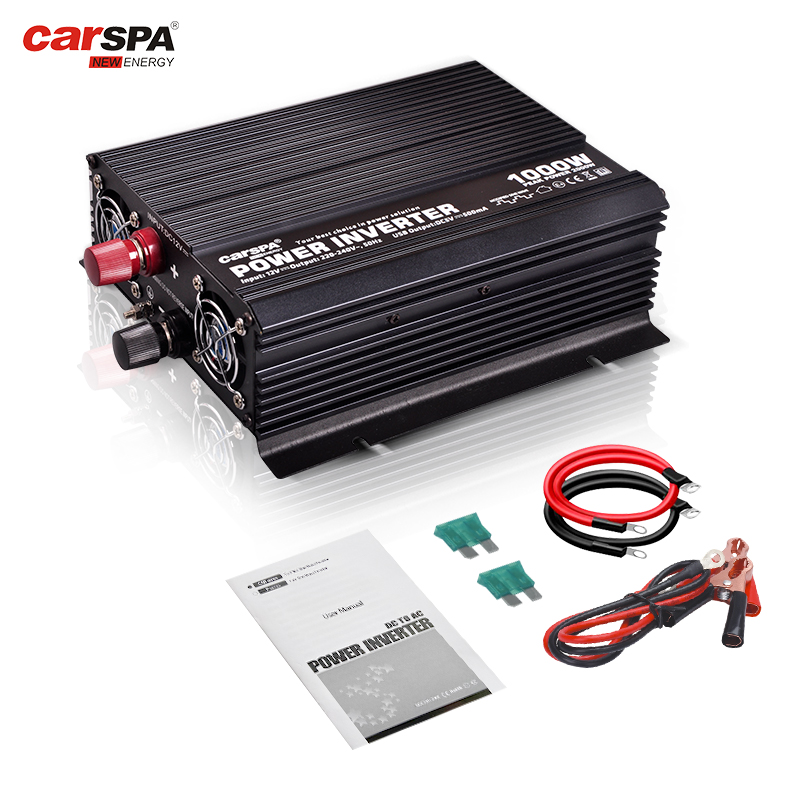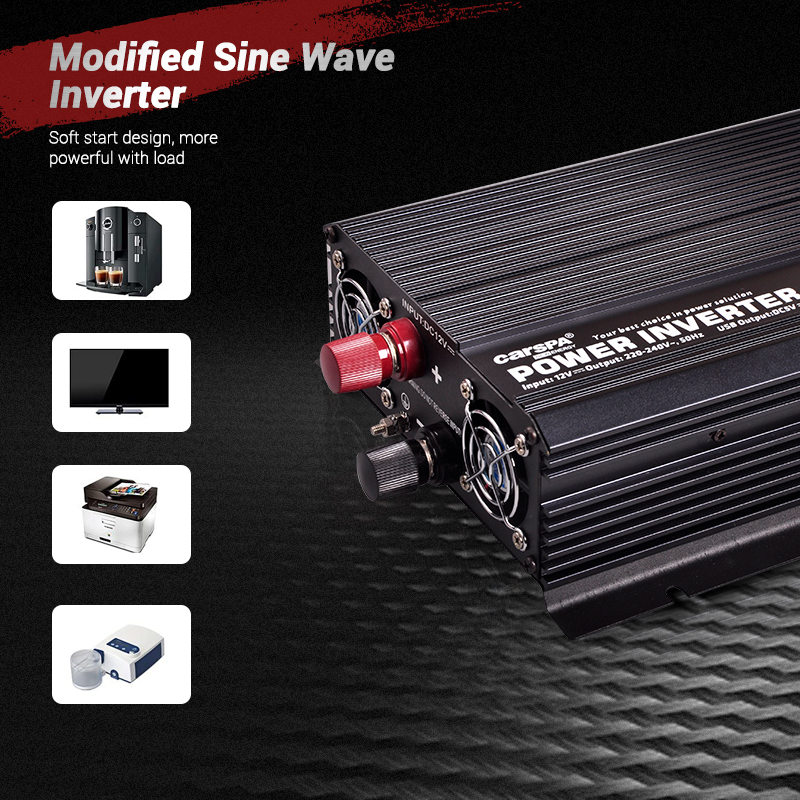How long can a 100Ah battery last with a 1000W inverter?
When using a 1000W inverter, many people will encounter a key question: If I use a 100Ah battery, how long can it support the inverter to run? This question involves multiple factors such as battery capacity, inverter efficiency, and load power of the equipment. In this article, we will explore in detail the matching of 100Ah batteries and 1000W inverters, and deeply analyze its continuous use time in actual applications, while providing tips and strategies to extend the use time.
Basic concepts of 100Ah batteries and 1000W inverters
What is a 100Ah battery?
The "Ah" in a 100Ah battery stands for Ampere Hour, which is the time the battery can provide current. A 100Ah battery means that the battery can run for 100 hours at 1 ampere current, or 10 hours at 10 amperes current. This capacity definition directly determines the amount of power a battery can store, which means how long it can power a device.
Battery capacity is not equivalent to the actual time it can power, because this depends on factors such as the power demand of the device, the fluctuation of the load, and the health of the battery. But 100Ah batteries are generally suitable for scenarios that require moderate continuous power, such as powering home devices, RV appliances, or emergency backup power.
What is a 1000W inverter?
A 1000W inverter is a device that can convert 12V direct current (DC) to 220V or 110V alternating current (AC). It is rated at 1000 watts, which means it can power devices with a total load power of no more than 1000W. 1000W inverters are suitable for many household appliances, such as TVs, fans, lamps, and even small refrigerators.
The inverter powers electrical devices by converting low-voltage DC power provided by batteries or solar panels into high-voltage AC power. Therefore, its power size determines the number and type of devices it can support.
Matching and applicability of batteries and inverters
When used with a 100Ah battery, a 1000W inverter is very suitable for outdoor camping, RV travel or emergency backup power. With the right battery selection and device load management, users can achieve longer power supply and provide enough power for multiple devices.
How to calculate the operating time of a 100Ah battery and a 1000W inverter?
Basic calculation formula
To calculate the operating time of a 100Ah battery supporting a 1000W power inverter, the following formula can usually be used:
Operation time (hours) = total battery power (Wh) × inverter efficiency / load power (W)
First, we need to calculate the total power of the battery (Wh). Take a 12V 100Ah battery as an example:
Total battery power = battery voltage (V) × battery capacity (Ah) = 12V × 100Ah = 1200Wh
Then, based on the efficiency of the inverter, we can calculate the operating time that the battery can support. Assuming the inverter efficiency is 90%:
Run time = 1200Wh × 90% / 1000W = 1.08 hours
This means that a 100Ah battery can support approximately 1.08 hours of run time at full load (1000W).
Run time under different loads
In actual use, the inverter does not always run at maximum power, and many times the load is much lower than 1000W. For example, if you use a 500W device, the battery run time will increase significantly:
Run time = 1200Wh × 90% / 500W = 2.16 hours
If the load is a 250W device, the run time will be longer:
Run time = 1200Wh × 90% / 250W = 4.32 hours
From these calculations, it can be seen that the smaller the load power, the longer the battery can be used. Therefore, when using an inverter, reasonably arranging the power of the device can extend the battery run time.
Factors Affecting the Running Time of Batteries and Inverters
Although the formula calculation can help us understand the theoretical value of the battery running time, there are some external factors that affect the actual use time of batteries and inverters in reality.
Battery Health
As the battery is used more, its health and actual capacity will decrease. The nominal capacity of a new battery is generally accurate, but after long-term use, the battery's charging capacity may gradually decrease. To ensure the health of the battery, users are advised to avoid overcharging or discharging the battery and to perform regular maintenance and care on the battery.
Inverter Efficiency
Inverters of different brands and models have different efficiencies. Efficient inverters can minimize power waste and extend battery life. Inverters with lower efficiency may generate more energy losses and shorten the battery's power supply time. Therefore, it is very important to choose a high-quality inverter. Efficient inverters provided by brands such as CARSPA can minimize losses during the conversion process.
Ambient Temperature
The ambient temperature has a great impact on the battery. Under low temperature conditions, the chemical reaction rate of the battery slows down, and the actual available capacity will drop significantly, resulting in a shorter power supply time. Under high temperature conditions, the battery may overheat, affecting its service life. To ensure the normal operation of the battery, it is recommended to use it in a suitable temperature environment and avoid extreme temperatures.
Load type and fluctuation
Some equipment has large power fluctuations, such as refrigerators, air conditioners, power tools, etc. The instantaneous power they require at startup may be much higher than the power during operation, resulting in an increase in the instantaneous load of the battery. If these loads are started more frequently, the battery discharge rate will be faster, and the actual use time may be shorter than the theoretically calculated time.
How to extend the use time of 100Ah battery and 1000W inverter?
Although the theoretical operating time of the battery and inverter can be calculated by formula, in actual use, we can extend their use time through some methods and techniques.
Reasonable load management
Users can extend the battery life by reducing unnecessary loads. For example, when high-power devices such as rice cookers and microwave ovens are not needed, avoid letting them work at the same time as the inverter. Users can also choose more energy-saving devices, such as LED lights instead of traditional bulbs, and low-power appliances instead of high-power devices.
Increase battery capacity
If a longer power supply time is required, users can extend the battery life by increasing the number of batteries. For example, by connecting two 100Ah batteries in parallel, the total capacity will increase to 200Ah. By increasing the number of batteries, users can significantly extend the power supply time of the inverter, which is suitable for scenarios with long-term power supply needs, such as RV travel or emergency backup power supply.
Use high-efficiency inverters
Choosing high-efficiency car inverters is an important means of energy conservation. High-efficiency inverters can minimize the loss in power conversion. Inverters from brands such as CARSPA are widely praised in the market for their high efficiency and stability. High-efficiency inverters can not only extend the battery life, but also protect the battery and equipment and extend their service life.
Application scenarios of 100Ah batteries and 1000W inverters
Outdoor activities
During outdoor camping or activities away from the power grid, 100Ah batteries and 1000W inverters can power a variety of devices, such as lamps, refrigerators, chargers, fans, etc. It can meet the basic power needs of camping activities and ensure that users' daily life will not be affected by power shortage.
RV travel
The combination of 100Ah battery and 1000-watt power inverter is very practical in RV travel. There are many electrical devices on the RV that need to be powered, such as TV, microwave oven, coffee machine, etc. Through reasonable planning, the inverter can provide continuous power support for these devices and improve the comfort during travel.
Emergency backup power supply
In the event of sudden power outage, 100Ah battery and 1000W RV inverter are ideal emergency power supply options. It can provide power support for lamps, routers, small appliances, etc., to ensure that family life will not be interrupted by short-term power outages.
Industrial and agricultural uses
In some small industrial or agricultural applications, 1000W inverter and 100Ah battery can power agricultural irrigation equipment, monitoring systems or emergency equipment in small factories. This configuration is flexible and portable, suitable for use in areas with unstable power supply.
Future Trends: Smart Power and Lithium Batteries
With the advancement of technology, the future development trend of batteries and inverters is moving towards a smarter and more efficient direction.
Application of Lithium Batteries
Lithium batteries are gradually replacing lead-acid batteries as the mainstream choice because of their high energy density, long life and lighter weight. Compared with traditional batteries, lithium batteries not only provide longer use time, but also can be charged quickly and improve power supply efficiency.
Intelligent Power Management System (BMS)
The intelligent power management system (BMS) can monitor the battery status in real time, such as voltage, current, temperature, etc., to ensure that the battery operates in the best condition. Through intelligent management, BMS can optimize battery use, extend battery life, and automatically alarm when abnormalities occur to prevent equipment damage.
Conclusion
Through the detailed analysis of this article, we can understand that the combination of 100Ah battery and 1000 watt power inverter can provide reliable power support in a variety of application scenarios. Through reasonable load management, increasing battery capacity and using efficient inverters, users can maximize battery life and ensure the normal operation of equipment. With the continuous advancement of battery and inverter technology, our users will be able to enjoy more efficient and smarter power solutions in the future.








